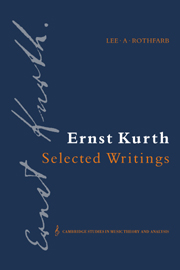Book contents
- Frontmatter
- Contents
- Foreword by Ian Bent
- Preface
- Notes on the translation
- Introduction
- Part I Grundlagen des linearen Kontrapunkts (Foundations of linear counterpoint)
- Part II Romantische Harmonik und ihre Krise in Wagners “Tristan” (Romantic harmony and its crisis in Wagner's “Tristan”)
- 4 Details of Romantic harmony
- 5 Broader dimensions of Romantic harmony
- Part III Bruckner
- Appendix: Complete tables of contents for Kurth's Grundlagen des linearen Kontrapunkts, Romantische Harmonik und ihre Krise in Wagners “Tristan” and Bruckner
- Select bibliography
- Index of musical examples
- General index
5 - Broader dimensions of Romantic harmony
Published online by Cambridge University Press: 10 December 2009
- Frontmatter
- Contents
- Foreword by Ian Bent
- Preface
- Notes on the translation
- Introduction
- Part I Grundlagen des linearen Kontrapunkts (Foundations of linear counterpoint)
- Part II Romantische Harmonik und ihre Krise in Wagners “Tristan” (Romantic harmony and its crisis in Wagner's “Tristan”)
- 4 Details of Romantic harmony
- 5 Broader dimensions of Romantic harmony
- Part III Bruckner
- Appendix: Complete tables of contents for Kurth's Grundlagen des linearen Kontrapunkts, Romantische Harmonik und ihre Krise in Wagners “Tristan” and Bruckner
- Select bibliography
- Index of musical examples
- General index
Summary
Having covered many local details in parts 2, 3, and 4 of Romantische Harmonik, 3rd edn., in part 5 (“Paths of tonal development”), Kurth broadens the harmonic perspective to embrace larger units. Already in part 3, chapter 5 (“The intensive alteration style”) he widens the harmonic context by examining “extratonal” progressions and introducing the idea of “basic pillars.” When each sonority in a series of chords is viewed as a neighbor-note displacement of its successor, the result is a chromatic progression, which generally leads to a logical tonal goal, i.e., to a basic pillar (“Chromaticism of chord connections,” pp. 219–28; see EKATA, pp. 181–85). In part 5, chapter 2, Kurth stretches the harmonictonal compass yet further in an investigation of sequences (“Paths of melodic innovation”). He analyzes a few short sequential passages (Exx. 5.4, 5.5, 5.6), and describes several large-scale sequences, one of which spans the first and second scenes in the first act of Tristan (pp. 342–43, 353–55).
One of the largest and most celebrated analyses in Romantische Harmonik is of the prelude to Act 1 of Tristan (part 5, chapter 1, “Paths of harmonic expansion,” pp. 318–27). Robert Bailey translates the analysis in Prelude and Transfiguration from “Tristan and Isolde” (New York: Norton, 1985, pp. 196–204). The only other extended analysis in Romantische Harmonik is of the prelude to Act 3 (pp. 314–18), which is translated below.
- Type
- Chapter
- Information
- Ernst Kurth: Selected Writings , pp. 130 - 148Publisher: Cambridge University PressPrint publication year: 1991



